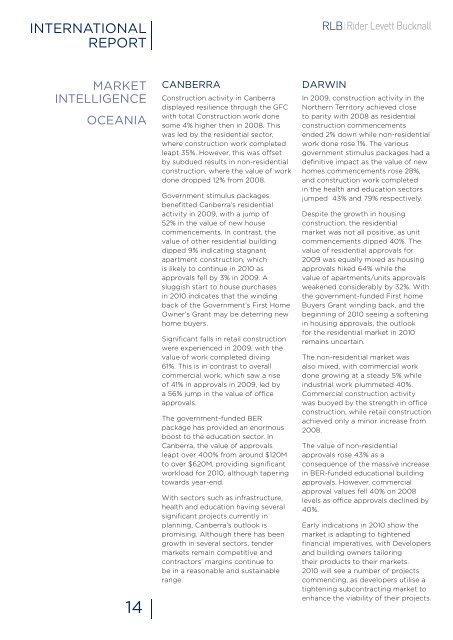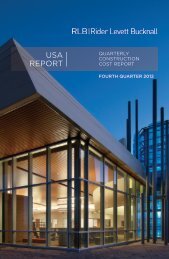Download... - Rider Levett Bucknall
Download... - Rider Levett Bucknall
Download... - Rider Levett Bucknall
Create successful ePaper yourself
Turn your PDF publications into a flip-book with our unique Google optimized e-Paper software.
INTERNATIONAL<br />
REPORT<br />
MARKET<br />
INTELLIGENCE<br />
OCEANIA<br />
14<br />
Canberra<br />
Construction activity in Canberra<br />
displayed resilience through the GFC<br />
with total Construction work done<br />
some 4% higher then in 2008. This<br />
was led by the residential sector,<br />
where construction work completed<br />
leapt 35%. However, this was offset<br />
by subdued results in non-residential<br />
construction, where the value of work<br />
done dropped 12% from 2008.<br />
Government stimulus packages<br />
benefitted Canberra’s residential<br />
activity in 2009, with a jump of<br />
52% in the value of new house<br />
commencements. In contrast, the<br />
value of other residential building<br />
dipped 9% indicating stagnant<br />
apartment construction, which<br />
is likely to continue in 2010 as<br />
approvals fell by 3% in 2009. A<br />
sluggish start to house purchases<br />
in 2010 indicates that the winding<br />
back of the Government’s First Home<br />
Owner’s Grant may be deterring new<br />
home buyers.<br />
Significant falls in retail construction<br />
were experienced in 2009, with the<br />
value of work completed diving<br />
61%. This is in contrast to overall<br />
commercial work, which saw a rise<br />
of 41% in approvals in 2009, led by<br />
a 56% jump in the value of office<br />
approvals.<br />
The government-funded BER<br />
package has provided an enormous<br />
boost to the education sector. In<br />
Canberra, the value of approvals<br />
leapt over 400% from around $120M<br />
to over $620M, providing significant<br />
workload for 2010, although tapering<br />
towards year-end.<br />
With sectors such as infrastructure,<br />
health and education having several<br />
significant projects currently in<br />
planning, Canberra’s outlook is<br />
promising. Although there has been<br />
growth in several sectors, tender<br />
markets remain competitive and<br />
contractors’ margins continue to<br />
be in a reasonable and sustainable<br />
range.<br />
Darwin<br />
In 2009, construction activity in the<br />
Northern Territory achieved close<br />
to parity with 2008 as residential<br />
construction commencements<br />
ended 2% down while non-residential<br />
work done rose 1%. The various<br />
government stimulus packages had a<br />
definitive impact as the value of new<br />
homes commencements rose 28%,<br />
and construction work completed<br />
in the health and education sectors<br />
jumped 43% and 79% respectively.<br />
Despite the growth in housing<br />
construction, the residential<br />
market was not all positive, as unit<br />
commencements dipped 40%. The<br />
value of residential approvals for<br />
2009 was equally mixed as housing<br />
approvals hiked 64% while the<br />
value of apartments/units approvals<br />
weakened considerably by 32%. With<br />
the government-funded First home<br />
Buyers Grant winding back, and the<br />
beginning of 2010 seeing a softening<br />
in housing approvals, the outlook<br />
for the residential market in 2010<br />
remains uncertain.<br />
The non-residential market was<br />
also mixed, with commercial work<br />
done growing at a steady 5% while<br />
industrial work plummeted 40%.<br />
Commercial construction activity<br />
was buoyed by the strength in office<br />
construction, while retail construction<br />
achieved only a minor increase from<br />
2008.<br />
The value of non-residential<br />
approvals rose 43% as a<br />
consequence of the massive increase<br />
in BER-funded educational building<br />
approvals. However, commercial<br />
approval values fell 40% on 2008<br />
levels as office approvals declined by<br />
40%.<br />
Early indications in 2010 show the<br />
market is adapting to tightened<br />
financial imperatives, with Developers<br />
and building owners tailoring<br />
their products to their markets.<br />
2010 will see a number of projects<br />
commencing, as developers utilise a<br />
tightening subcontracting market to<br />
enhance the viability of their projects.

















